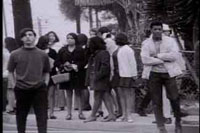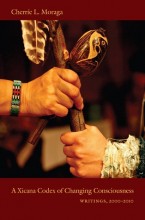The East L.A. blowouts in 1968 was a huge step taken by the Chicano community to improve the school system. By the mid-1960s, many Mexican American students that were part of the Los Angeles Unified School System had experienced social injustice and discrimination in their high schools.In order to address these discrimination issues in the high schools, David Sanchez, a teenage social activist, created an organization known as Young Citizens for Community Action (YCCA) in 1967. YCCA succeeded in helping to elect Julian Nava as the first Mexican American to the Los Angeles School Board. Sanchez changed YCCA into a more militant group known as the Brown Berets who took on a more militant approach to achieve their desired social change, since he wasn’t satisfied with the progress of YCCA.Throughout the early 1960s, Mexican American youth experienced inferior educational opportunities throughout the Southwest of the United States. It was common for Mexican American students to be punished for speaking Spanish at school, or to be channeled into shop and agricultural classes rather than college preparatory classes. In the four East Los Angeles high schools of Garfield, Roosevelt, Lincoln and Wilson, which had a high majority of Mexican American students, the drop out rate was as high as 60%.Chicano teachers and students along withe the two groups, the United Mexican American Students (UMAS) and the Brown Berets, developed thirty-six demands to bring to the Board of Education to improve the Chicano community schools.The goals were bilingual, bi cultural education, Latino teachers and administrators, smaller class sizes, better facilities and the revision of text books to include Mexican American history.
that were part of the Los Angeles Unified School System had experienced social injustice and discrimination in their high schools.In order to address these discrimination issues in the high schools, David Sanchez, a teenage social activist, created an organization known as Young Citizens for Community Action (YCCA) in 1967. YCCA succeeded in helping to elect Julian Nava as the first Mexican American to the Los Angeles School Board. Sanchez changed YCCA into a more militant group known as the Brown Berets who took on a more militant approach to achieve their desired social change, since he wasn’t satisfied with the progress of YCCA.Throughout the early 1960s, Mexican American youth experienced inferior educational opportunities throughout the Southwest of the United States. It was common for Mexican American students to be punished for speaking Spanish at school, or to be channeled into shop and agricultural classes rather than college preparatory classes. In the four East Los Angeles high schools of Garfield, Roosevelt, Lincoln and Wilson, which had a high majority of Mexican American students, the drop out rate was as high as 60%.Chicano teachers and students along withe the two groups, the United Mexican American Students (UMAS) and the Brown Berets, developed thirty-six demands to bring to the Board of Education to improve the Chicano community schools.The goals were bilingual, bi cultural education, Latino teachers and administrators, smaller class sizes, better facilities and the revision of text books to include Mexican American history.
Since the board didn’t meet their demands,the plan was to stage a massive walk-out from the four schools on the same day and thereby cost the school system thousands of dollars in unearned stipends. The Chicano activist groups were aware that the city schools received a daily stipend for each student attending school, so they decided to hurt the school system financially. Although the plan was to be a coordinated walk-out from all four schools, on March 1, 1968, 300 hundred students at Wilson high school jumped the gun and stormed out of school to protest the canceling of a school play.
The walkouts still went successfully as planned with the other schools.On March 5, 1968, two thousand students walked out of Garfield High. They were met by policemen and an angry administration. The next day 2700 students walked out and students continued to walk out on the 7th and the 8th. Students from Roosevelt High School walked out next on March 6. Even though the principal locked the school gate to prevent them, the students climbed over the fence where police officers beat the students.On March 8, Belmont High students tried to walk out, but police invaded their school and arrested and beat students.After the week of protests, the LA Board of Education set a meeting for March 11. Chicano students, parents, professors, and community members formed the Educational Issues Coordinating Committee (EICC) as their representative voice for the Board meeting. At the meeting, the EICC asked for amnesty for all students involved in the walkouts as well as a community meeting to discuss the needed education reform. The Board agreed to the meeting and the students returned to school.
There were 1,200 people that attended the community meeting held at Lincoln High on March 28. The EICC presented the original 36 demands to the Board, which the board agreed to. The struggles that the Chicano activist had to deal with was similar to that of the Chicana feminist movement. It was assumed Mexican American students weren’t going to college ,so they weren’t put in college prep classes but steered towards shop and agricultural classes.Such low expectations were put on the women of the Chicano movement by the men. The men assumed the women couldn’t be group leaders or that their opinions and voices didn’t matter in the Chicano movement. However, the Chicana women did not let the ender estimation of the Chicano men stop them from proving they were capable of helping the Chicano movement. The Chicana women proceeded to form numerous Chicana groups that effectively helped the Chicana and Chicano movement.
To see a documentary on the East L.A. Blowout in 1968 look at the following link:
http://www.youtube.com/watch?feature=player_embedded&v=NL4rQHKza9Y
Here is a copy of the 36 demands the Chicano groups and the East L.A. community presented to the board:
ACADEMIC
I. No student or teacher will be reprimanded or suspended for participating in any efforts which are executed for the purpose of improving or furthering the educational quality in our schools.
II. Bilingual–Bi-cultural education will be compulsory for Mexican-Americans in the Los Angeles City School System where there is a majority of Mexican-American students. This program will be open to all other students on a voluntary basis. A) in-service education programs will be instituted immediately for all staff in order to teach them the Spanish language and increase their understanding of the history, traditions, and contributions of the Mexican culture. B) All administrators in the elementary and secondary schools in these areas will become proficient in the Spanish language Participants are to be compensated during the training period at not less than $8.80 an hour and upon completion of the course will receive in addition to their salary not less than $100.00 a month. The monies for these programs will come from local funds, state funds and matching federal funds.
III. Administrators and teachers who show any form of prejudice toward Mexican or Mexican-American students, including failure to recognize, understand, and appreciate Mexican culture and heritage, will be removed from East Los Angeles schools. This will be decided by a Citizens Review Board selected by the Educational Issues Committee.
IV. Textbooks and curriculum will be developed to show Mexican and Mexican-American contribution to the U.S. society and to show the injustices that Mexicans have suffered as a culture of that society. Textbooks should concentrate on Mexican folklore rather than English folklore.
V. All administrators where schools have majority of Mexican-American descent shall be of Mexican-American descent. If necessary, training programs should be instituted to provide a cadre of Mexican-American administrators.
VI. Every teacher’s ratio of failure per students in his classroom shall be made available to community groups and students. Any teacher having a particularly high percentage of the total school dropouts in his classes shall be rated by the Citizens Review Board composed of the Educational Issues Committee.
ADMINISTRATIVE
I. Schools should have a manager to take care of paper work and maintenance supervision. Administrators will direct the Education standards of the School instead of being head janitors and office clerks as they are today.
II. School facilities should be made available for community activities under the supervision of Parents’ Councils (not PTA). Recreation programs for children will be developed.
III. No teacher will be dismissed or transferred because of his political views and/or philosophical disagreements with administrators.
IV. Community parents will be engaged as teacher’s aides. Orientation similar to in-service training, will be provided, and they will be given status as semi-professionals as in the new careers concept.
FACILITIES
I. The Industrial Arts program must be re-vitalized. Students need proper training to use the machinery of modern day industry. Up-to-date equipment and new operational techniques must replace the obsolescent machines and outmoded training methods currently being employed in this program. If this high standard cannot be met, the Industrial Arts program will be de-emphasized.
II. New high schools in the area must be immediately built. The new schools will be named by the community. At least two Senior High Schools and at least one Junior High School must be built. Marengo Street School must be reactivated to reduce the student-teacher load at Murchison Street School.
III. The master plans for Garfield High School and Roosevelt High School must go into effect immediately.
IV. Library facilities will be expanded in all East Los Angeles high schools. At present the libraries in these high schools do not meet the educational needs of the students. Sufficient library materials will be provided in Spanish.
V. Open-air student eating areas should be made into roofed eating malls. As an example, Los Angeles High School.
STUDENT RIGHTS
I. Corporal punishment will only be administrated according to State Law.
II. Teachers and administrators will be rated by the students at the end of each semester.
III. Students should have access to any type of literature and should be allowed to bring it on campus.
IV. Students who spend time helping teachers shall be given monetary and/or credit compensation.
V. Students will be allowed to have guest speakers to club meetings. The only regulation should be to inform the club sponsor.
VI. Dress and grooming standards will be determined by a group of a) students and b) parents.
VII. Student body offices shall be open to all students. A high grade point average shall not be considered as a pre-requisite to eligibility.
VIII. Entrances to all buildings and restrooms should be accessible to all students during schools hours. Security can be enforced by designated students.
IX. Student menus should be Mexican oriented. When Mexican food is served, mother from the barrios should come to the school and help supervise the preparation of the food. These mothers will meet the food handler requirements of Los Angeles City Schools and they will be compensated for their services.
X. School janitorial services should be restricted to the employees hired for that purposes by the school board. Students will be punished by picking up paper or trash and keeping them out of class.
XI. Only area superintendents can suspend students.
Sources:







